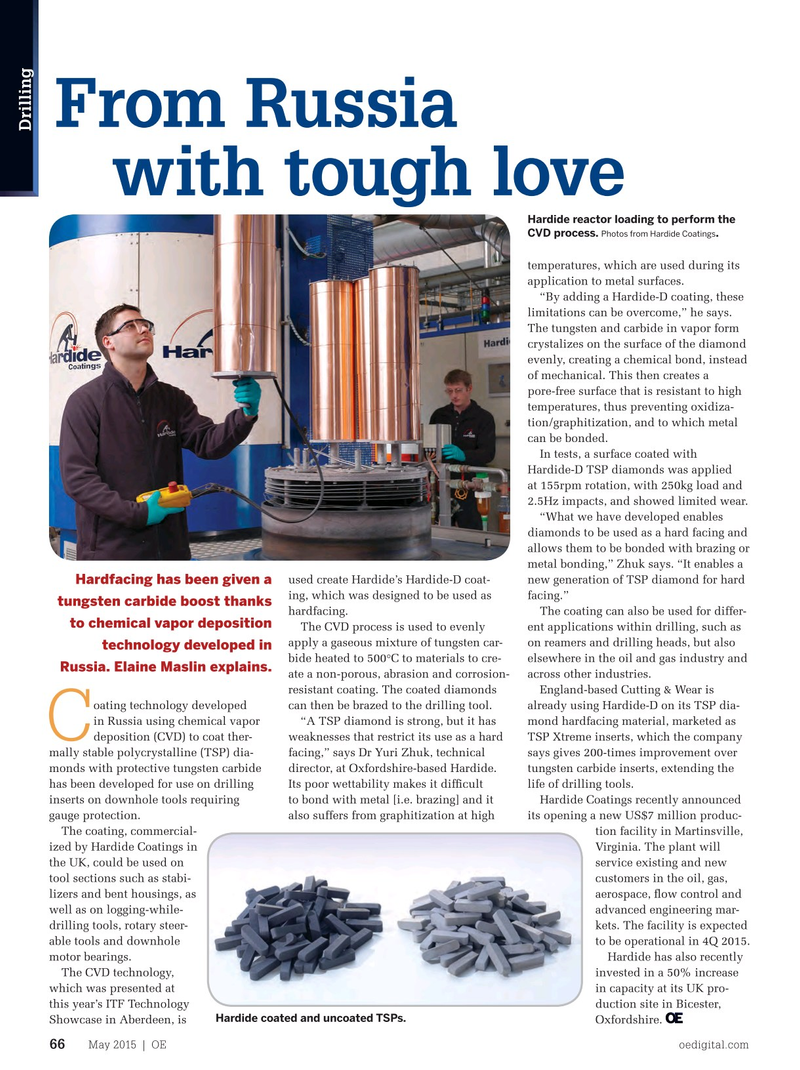
Page 64: of Offshore Engineer Magazine (May/Jun 2015)
Read this page in Pdf, Flash or Html5 edition of May/Jun 2015 Offshore Engineer Magazine
From Russia
Drilling with tough love
Hardide reactor loading to perform the
Photos from Hardide Coatings
CVD process. .
temperatures, which are used during its application to metal surfaces. “By adding a Hardide-D coating, these limitations can be overcome,” he says.
The tungsten and carbide in vapor form crystalizes on the surface of the diamond evenly, creating a chemical bond, instead of mechanical. This then creates a pore-free surface that is resistant to high temperatures, thus preventing oxidiza- tion/graphitization, and to which metal can be bonded.
In tests, a surface coated with
Hardide-D TSP diamonds was applied at 155rpm rotation, with 250kg load and 2.5Hz impacts, and showed limited wear.
“What we have developed enables diamonds to be used as a hard facing and allows them to be bonded with brazing or metal bonding,” Zhuk says. “It enables a used create Hardide’s Hardide-D coat- new generation of TSP diamond for hard
Hardfacing has been given a ing, which was designed to be used as facing.” tungsten carbide boost thanks hardfacing. The coating can also be used for differ- to chemical vapor deposition
The CVD process is used to evenly ent applications within drilling, such as apply a gaseous mixture of tungsten car- on reamers and drilling heads, but also technology developed in bide heated to 500°C to materials to cre- elsewhere in the oil and gas industry and
Russia. Elaine Maslin explains. ate a non-porous, abrasion and corrosion- across other industries.
resistant coating. The coated diamonds England-based Cutting & Wear is oating technology developed can then be brazed to the drilling tool. already using Hardide-D on its TSP dia- in Russia using chemical vapor “A TSP diamond is strong, but it has mond hardfacing material, marketed as
C deposition (CVD) to coat ther- weaknesses that restrict its use as a hard TSP Xtreme inserts, which the company mally stable polycrystalline (TSP) dia- facing,” says Dr Yuri Zhuk, technical says gives 200-times improvement over monds with protective tungsten carbide director, at Oxfordshire-based Hardide. tungsten carbide inserts, extending the has been developed for use on drilling Its poor wettability makes it diffcult life of drilling tools.
inserts on downhole tools requiring to bond with metal [i.e. brazing] and it Hardide Coatings recently announced gauge protection. also suffers from graphitization at high its opening a new US$7 million produc-
The coating, commercial- tion facility in Martinsville, ized by Hardide Coatings in Virginia. The plant will the UK, could be used on service existing and new tool sections such as stabi- customers in the oil, gas, lizers and bent housings, as aerospace, fow control and well as on logging-while- advanced engineering mar- drilling tools, rotary steer- kets. The facility is expected able tools and downhole to be operational in 4Q 2015. motor bearings. Hardide has also recently
The CVD technology, invested in a 50% increase which was presented at in capacity at its UK pro- this year’s ITF Technology duction site in Bicester,
Hardide coated and uncoated TSPs.
Showcase in Aberdeen, is Oxfordshire.
May 2015 | OE oedigital.com 66 066_OE0515_D&C5_Hardide.indd 66 4/20/15 3:23 PM

 63
63

 65
65